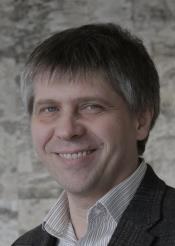 |
Professor of Information and Computer Systems in AutomationAalto University, Helsinki, FinlandChaired Professor (Professor och Ämnesföreträdare) of Dependable Communications and Computations (Kommunikations-och-berakningssystem)Luleå University of Technology, Luleå, Sweden |
Valeriy Vyatkin (M’03, SM’04) received Ph.D. degree in applied computer science from Taganrog State University of Radio Engineering (TSURE), Russia, in 1992, Dr. Eng. degree in electrical engineering from Nagoya Institute of Technology, Japan in 1999, Dr. Sc. (Eng.) degree in information and control systems in 1999 from TSURE, and Habilitation degree from the Ministry of Science and Technology of Sachsen-Anhalt, Germany in 2002.
He is on joint appointment as Chaired Professor (Ämnesföreträdare) of Dependable Computation and Communication Systems, Luleå University of Technology, Luleå, Sweden, and Professor of Information and Computer Engineering in Automation at Aalto University, Helsinki, Finland. He is also co-director of the international research laboratory of Computer Technologies at ITMO University, St. Petersburg, Russia.
Previously, he was a Visiting Scholar at Cambridge University, U.K., and had permanent academic appointments with the University of Auckland, Auckland, New Zealand; Martin Luther University of Halle-Wittenberg, Halle, Germany, as we'll as in Japan and Russia.
His research interests include dependable distributed automation and industrial informatics; software engineering for industrial automation systems; artificial intelligence, distributed architectures and multi-agent systems applied in various industry sectors, including smart grid, material handling, building management systems, data centres and reconfigurable manufacturing.
Dr. Vyatkin was awarded the Andrew P. Sage award for the best IEEE Transactions paper in 2012. He has been the Chair of IEEE IES Technical Committee on Industrial Informatics since 2016.
On cyber-physical engineering of industrial automation systems
The term “cyber-physical systems” (CPS) has become very widely used in the context of future manufacturing systems driven by modern information and communication technologies (ICT) to emphasize their distributed architecture with myriads of control nodes tightly embedded to the physical process and communicating by means of wireless networks. The global buzz around CPS has largely dissolved the meaning of this term that has been developing in the research in the last decade or two. Nevertheless, transition to the so-called CPS raises questions of appropriate engineering process and the corresponding architectures.
Some experts believe in the cloud-based architecture, while other argue for the edge computing. Who is right? What impact would these architectures have on the engineering process? Is there the corresponding cyber-physical engineering (CPE)? What are main characteristics of it?
Answer to these questions depends on how control decisions are to be made in
the automation CPS, centrally or in a decentralised way?
One clear sign of the CPE is the growing importance of process models. Traditionally, simulation models have been used at the system prototyping stage, for example, to convince the customer in the feasibility, or to estimate performance parameters of the system, e.g. its throughput. The progress in physical simulation technologies (originated, for example, to gaming, movies production, etc.) makes it affordable for wider application in system validation.
The demand for such validation is growing due to the drastically increasing complexity of automation software. Another means to manage the complexity is decomposition of system into smaller units. This gave rise to several distributed automation architectures, such as multi-agent, service-oriented and component based. These can considerably improve efficiency of system development, maintenance, and its robustness. But, can these approaches be made more intelligent to allow automation systems to adapt themselves to new requirements seamlessly? And, how could the distributed control architectures be combined with the process modelling?
The demand for such validation is growing due to the drastically increasing complexity of automation software. Another means to manage the complexity is decomposition of system into smaller units. This gave rise to several distributed automation architectures, such as multi-agent, service-oriented and component based. These can considerably improve efficiency of system development, maintenance, and its robustness. But, can these approaches be made more intelligent to allow automation systems to adapt themselves to new requirements seamlessly? And, how could the distributed control architectures be combined with the process modelling?
A related challenge is model development. How can the modern computational techniques be used to make such development less laborious task? We will discuss how modern data-driven approaches could be used to simplify model creation.
Models of the process are important for software testing. We will demonstrate they use in the testing framework and in model-checking frameworks. And, finally, models can be used online, during system operation for many useful purposes, e.g. for the change impact assessment. They are also essential to develop supervisors and to synthesize automatically the control code for a given set of requirements.
These aspects of model use in engineering of automation CPS form the core of the proposed cyber-physical engineering approach, that is the focus of the talk. The talk will be concluded with discussion of educational support for the CPE.
;